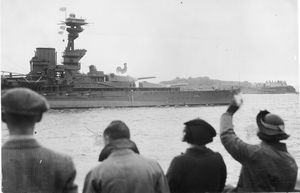Catalogue number 102076
HMS Royal Oak, Cock of the Fleet
This photograph may be from 1938 and shows HMS Royal Oak as Cock of the Fleet. Having won the most pulling races, she is allowed to display the huge cockerel on the top of B turret. The crew are lining the decks whilst friends and family welcome them home. The door-like structure in the hull just in front of the gun barrel may be the opening for the above-water experimental torpedo tubes fitted in the 1920s and taken out in 1930. The Rusty Anchor cited in the accompanying text is a turning point on the way into Devonport. This photograph may have been printed the wrong way round because the buildings on shore should be on the starboard side of HMS Royal Oak when entering Devonport.
Verso: "Cock of the fleet in port again. Plymouth, Devonshire, England, July 10 - - H.M.S. Royal Oak, champion sporting ship of the Fleet, with a huge cock above her second gun turret, denoting she is Cock of the Fleet, arrived here, her home port, this evening. It was a proud moment for the giant vessel, and crowds gave her a lusty welcome, as wives and sweethearts waved and cheered.
The Royal Oak arriving at Rusty Anchor, Plymouth, this evening, July 10, the cock proudly in evidence, while crowds gather to watch the ship approach."
17.9cm x 12.4cm Gelatin silver print
|
 |